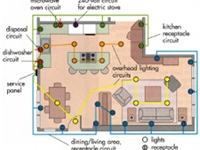
The Basic Home Electrical System
Important Notice: Our web hosting provider recently started charging us for additional visits, which was unexpected. In response, we're seeking donations. Depending on the situation, we may explore different monetization options for our Community and Expert Contributors. It's crucial to provide more returns for their expertise and offer more Expert Validated Answers or AI Validated Answers. Learn more about our hosting issue here.

The Basic Home Electrical System
You must be logged in to post a comment.
There are many reasons why homeowners should understand their electrical system. Whether it be to save time, to be able to explain a situation over the phone, or in the event of an emergency, having a basic understanding can go a long way. While many homes have different designs for their electrical system they all work on the same basic principles, there is a service and a main panel with branch circuits. While some systems may have more than one main panel, most do not.
Electricity is supplied from the local utility to what is known as the service. The service is the first point of connection for electricity to the home and is also the location where metering is done. Most often this canister is approximately 18 inches square and has the meter in it. From this point forward single line voltage would be measured between 110 and 125 volts. Dual line voltage will be measured between 220 and 250 volts. This will also be the location for the grounding electrode and conductor for the system. Feeders will carry power to the main panel<s>.
While the service is typically locked out to the homeowner, inspection of the grounding system should be a part of regular home maintenance. Homeowners can check connections for tightness and make adjustments as necessary. If the connections appear loose, turn off the main breaker to the building before making adjustments, as this is the only ground for the building and you do not want to become the path for electricity.
The main panel will be the first point of disconnect after the service. This will be identified by a breaker that is labeled as ‘main’. This main breaker will control power to the rest of the breakers in the panel. There may be as few as eight breakers, while there can be as many as 42 in a single panel. These breakers will control what is known as branch circuits. Branch circuits are used for lighting and equipment within the home. The main panel may also have a breaker that feeds what is known as a subpanel, or a secondary panel. This breaker will feed another panel in another location.
Homeowners can inspect the panel for cleanliness and check breakers to make sure the wires are secured. Loose particles and dust can spontaneously combust so removing any contaminants from the panel is always a good idea. A vacuum does this job very well. Over years of use, electrical terminations he up and cool off, causing some connections to work themselves loose. This can cause intermittent power issues or even shorten the life of light bulbs. Making sure the power is off, using a flat blade screwdriver, the homeowner can try to turn the screws on the breakers to ensure they are tight. This will also be a good time to check any other screws that the screwdriver will fit. Note most likely the main feeders coming into this panel and going to the main breaker or still live. Be sure not to touch the bare parts of these wires or their terminations as this can result in electrocution.
Now you should have a basic idea of the design of your home’s electrical system. When speaking with a technician over the phone, you can specify if the problem is with a branch circuit or the entire main panel. In the event of a fire, you now know that turning off the main breaker will disconnect power to the entire building, thus possibly preventing the fire from growing due to electrical shorts. You may also be able to save a service call for something as simple as a loose wire.